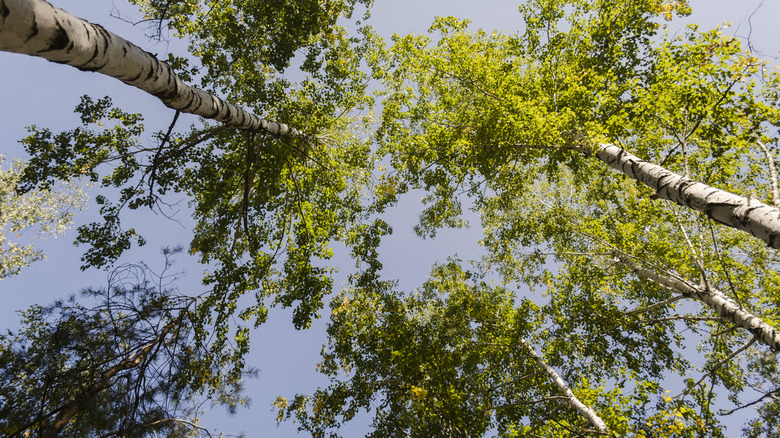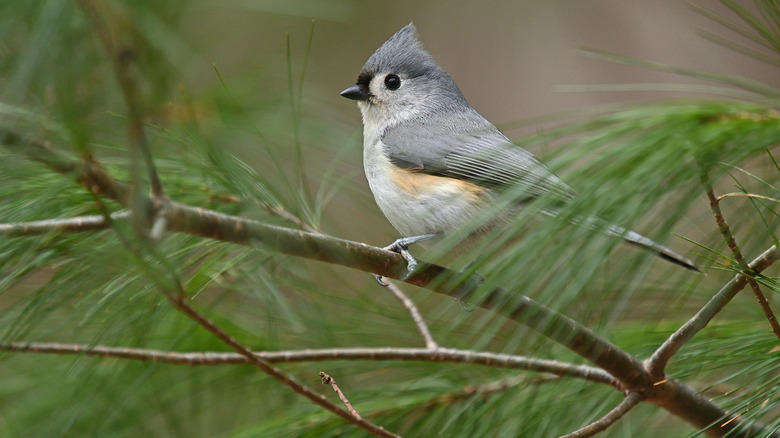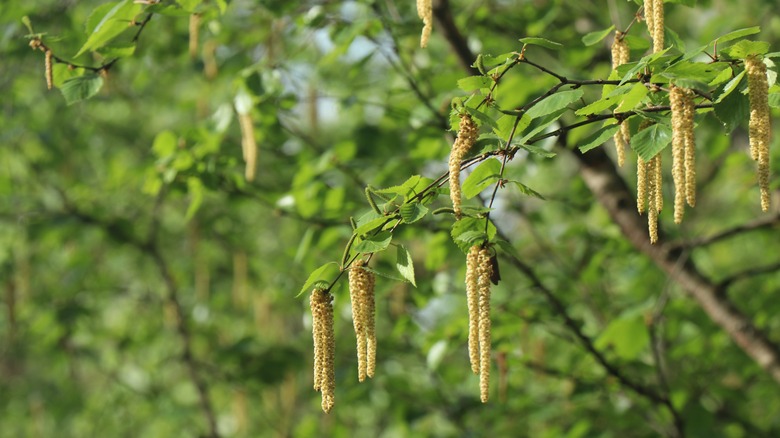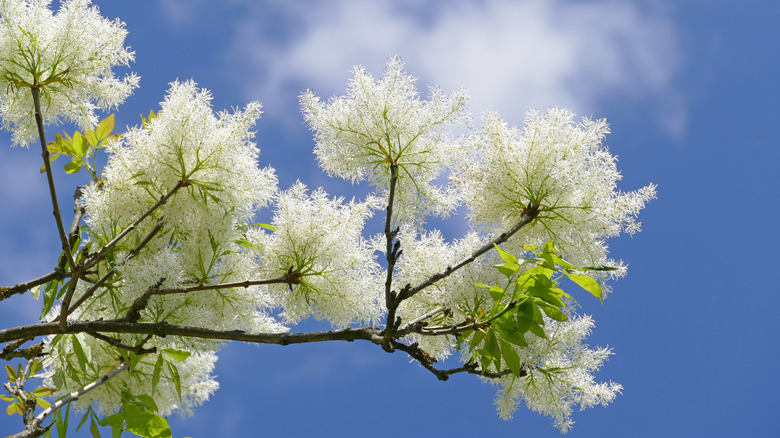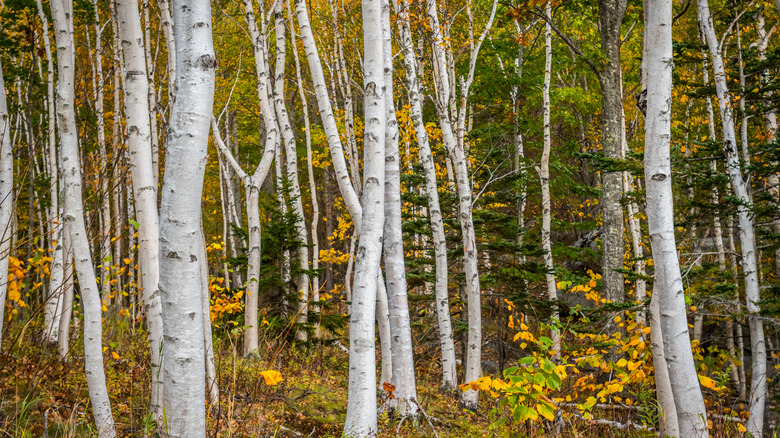The 13 Most Fragrant Trees That'll Make Your Yard Smell Better Than Ever
There is more than one way to make your yard smell fantastic! While most people think of bright, brooming flowers when trying to make their lawn a more pleasant place to be, there are lots of trees that can also do the trick. Whether you are trying to cover up a bad smell coming from somewhere else, want to enhance the experience of enjoying your morning cup of coffee on the porch, or just want a whiff of something fantastic while walking out to get the mail — there are dozens of trees to choose from.
To make things easier for you, we've cultivated a list of trees that are native to many different parts of North America. We've left out the pesky invasive species (however good they might smell), so you don't have to worry about contributing to any overgrowth. Whether you live in chilly northern Maine or balmy south Florida, we've selected options from many different USDA growing zones. There are also trees that require a lot of upkeep alongside ones that don't need a second glance. Whatever your preference, these are our favorite fragrant trees that'll make your yard smell better than ever.
1. The eastern red cedar (Juniperus virginiana) smells like a clean house
There is nothing quite like the smell of cedar, except in this case — the eastern red cedar is actually a juniper, as seen in its Latin name. Yet its bark and sap have the classic strong and woody cedar scent that makes it nice to have around. These trees are also known for sheltering wildlife, like birds and small mammals. This tree typically grows in the east of the USA and parts of southern Canada. It does best in USDA growing zone 2 through 9, which means it can thrive in both colder and warmer climates with the proper care. Whether you live in Toronto, Orlando, or even as far west as Austin, your yard can benefit from an eastern red cedar.
Because of how the tree's root system grows, the soil doesn't need to be particularly rich or deep. Because of this, the tree doesn't tend to get as tall as others. There have been trees known to reach about 70 feet tall, while the typical plant is around 40 feet tall. You can propagate this tree by either seed or cutting, whatever you prefer. You should keep a close eye on it spreading, though, as it does so easily and could take over your lawn or garden without management.
2. The balsam fir (Abies balsamea) smells fresh and crisp
The balsam fir has all the classic smell markers of any other pine tree. Its needles and sap have a sharp, fresh scent. It's almost like a naturally occurring car freshener or your favorite type of dish soap. In fact, you likely recognize this scent from your favorite self-care products, as it's a popular ingredient. Because it's a type of pine tree, it drops both cones and needles throughout the year. You can usually smell the pine through wind, but we find that the scent is most noticeable during yard work, when the dropped bits of the plant are agitated.
The balsam fir grows best up where it's quite cold. You'll find this conifer naturally occurring most in parts of Canada, but also in the far northern bits of the American states along the border. It also is known for its height and can grow up to 75 feet high. For this reason, it's best to consider growing this tree only if you have enough land for that height to not encroach on your neighbors' space.
3. The white pine (Pinus strobus) smells like Christmas
The white pine has quite a subtle scent, but like most pine trees, it still smells clean and fresh, especially if you rub its needles. Because of this subtly, many report that even if they are allergic to pine, they can stand this tree. This leads it to become a very popular choice for people who want living Christmas trees. It typically grows best in the northeast parts of the United States and the southeast bits of Canada. These trees will be around for generations, as they typically last 200 years, but can remain for over 400 years in some cases.
The white pine not only smells good, but it's also fantastic to have in your yard. All trees take carbon dioxide from the air and stores it inside their trunks, but pines in particular are good carbon sinks. Not only that, but the white pine puts other particles into the atmosphere that help to form clouds. This makes the local ecosystem a little cooler, which can help plants to thrive. While you might not see the results on a micro level in your yard, planting white pines contributes to a bigger-picture solution.
4. The eastern hemlock (Tsuga canadensis) is zesty
The eastern hemlock has a distinct smell. It's like a mix of crisp, fresh pine and sharp lemon. We've noticed the smell is especially nice after a rainstorm, as the water drops seem to enhance the tree's scent and help it travel farther. This tree is not related to the poisonous hemlock, so it's not a danger to pets to have in your yard.
This tree is sometimes called the Canada hemlock or hemlock spruce. It is native to the areas immediate to the Adirondack Mountains of New York state. However, it does well in the climate as far south as the bottom end of the Appalachian Mountains toward northern Georgia and even Alabama. In general, this tree will thrive in USDA zones 3 to 8. It is also the state tree of Pennsylvania. To the layman, they are quite visually similar to the balsam fir, as both have skinny green needles as leaves and grow around the same places. Because the branches are so dense, birds and small mammals love using the tree as a home, bringing even more value to your yard.
5. The sweet birch (Betula lenta) smells sweet, just like its name
You know a tree is going to smell nice when it has "sweet" right there in its name. The sweet birch tree has a scent that is like chewing on a fresh stick of spearmint gum. It's fresh, it's sharp, and it just smells clean. These trees do well in USDA zones 3 to 7. This means you'll find them thriving from Vermont and New Hampshire, over in most of the Midwestern states, and even as far south as Alabama! You might sometimes hear the tree called the cherry birch, instead — but both are the same.
If found in the forest, these trees can be as tall as 80 feet. When grown domestically, they fall a bit short, typically around 50 feet tall — but with a canopy of up to 45 feet across. Because of their size, it's best to only consider growing these trees if you have the space in your yard, no matter how good they smell. They can easily end up in your neighbors space (or monopolizing your entire lawn) unless you have at least an acre or two.
6. The black cherry (Prunus serotina) smells floral and expensive
The black cherry tree is known for its fragrant white flowers that give way to clusters of blood-red fruit. These cherries are harmless to humans and have been enjoyed historically for their tartness. They can be eaten raw, or made into jams, candies, or even liquors. However, parts of the tree can be harmful when ingested by some wildlife, as the leaves have compounds in them that are toxic. Same for the bark and seeds, so be careful. This is also something to consider if you have pets. The best way to describe the scent of the flowers is soft, sweet, and floral — a bit like an expensive perfume. Break a twig in half, though, and you'll get a much more unpleasant smell.
This tree grows well in all eastern states, sometimes in the Midwest, and in most parts of Canada, too. Some have even been found growing without a problem as far south as Guatemala. So no matter your USDA zone, the black cherry is a tough tree that will thrive. It's easy to take care of, and its blossoms and thick, sprawling branches make it an enjoyable tree to have in your garden.
7. The American basswood (Tilia americana) smells like summertime
American basswood trees smell delicious. In fact, if you're out for a walk and catch a whiff of one, it's unlikely you will be able to continue your journey until you find out where that overwhelmingly sweet scent is coming from! The tree tends to blossom in June, making them ideal places to enjoy picnics under in the warmer summer months. This is perfect, as the plant's scent is best described as what summer feels like. It's fragrant, it's sweet, and very, very floral. It has dense, heart-shaped leaves creating perfect shade — not just for picnickers, but for blue jays and other birds too. The tree is native to Chicago, although it does just as well in USDA zones 3 through 8 as well — throughout really all of the Northeast.
It needs plenty of rain to grow but is a little picky about its soil not being too moist. Thus, it needs to be in a spot with good drainage. Keep an eye out for pests like aphids, linden borers, and Japanese beetles, as they will eat basswood trees alive. Fungal diseases like anthracnose and verticillium wilt also threaten the trees, so they need a little care.
8. Sassafras (Sassafras albidum) smells like a lemon cupcake
Sassafras has long been an important tree to the indigenous peoples of North America. The tree gets its smell from a chemical called geranyl acetate. It is a type of compound known as a monoterpene that has the signature scent sassafras is so well-known for. The scent can best be described as a bit like a bakery, with hints of anise, cinnamon, and vanilla — but with a touch of citrus, too. Its bark also smells delicious and has been used for generations in teas for soothing ailments. Yet an oil from the tree, safrole, has been thought to cause cancer — so it's best to use commercially prepared options.
The size of the tree depends on where in the country you are growing it. It's a diverse tree that does well in many different climates, so it thrives in New England and in the deep South. However, the different temperatures cause the trees that grow in the cold to be short, but trees that have longer periods of heat to soar up to 80 feet tall.
9. The American chestnut (Castanea dentata) smells fresh and mild
Chestnut trees tend to smell earthy and woody. In the fall, as the chestnuts they drop begin to dry out, the scent gets stronger. While it's not floral, it's a very natural scent that we think is quite pleasant. The trees grow tall and wide, making a bold statement. In addition to smelling nice, they are great to look at, too. The American chestnut is special in that it nearly went extinct in the early 1900s. The number of trees, once in the billions across the United States, fell to as few as 100 plants. This is because of two terrible diseases: ink disease and chestnut blight.
Yet scientists are in the process of bringing the American chestnut back from the brink of extinction. If you want to be a part, you can contact the American Chestnut Foundation. Seeds can be sent to all states to the west, excluding California, Oregon, Washington, Hawaii, and Alaska. Seeds and seedlings are shipped to the Eastern U.S. If you don't want to grow a big tree but still want to do your part, there are plenty of other endangered plants native to the U.S. that you can grow in your garden.
10. The white ash (Fraxinus cuspidata) smells like an afternoon hike
The white ash tree is most commonly found in Texas. It's sometimes called the flowering ash or fragrant ash. Both of its names seem to come from its massive canopy of white, fluffy blossoms. The flowers smell sweet and are known to send a sweet, floral smell wafting over the trails in Texas. When not in bloom, the tree is known for its lush green canopy. You can find them in the wild all over Texas and parts of Oklahoma, too, though its range also extends south of Texas into Mexico. It does well in rocky soil conditions, so if you have a yard with desert landscaping, this tree could be the perfect fit to make it smell nicer.
Because the white ash is first and foremost a desert plant, it doesn't require much water or general upkeep. If you are looking for a tree that smells fantastic, looks almost regal due to its many flowers, but is very much set-and-forget, consider the white ash.
11. The Douglas fir (Pseudotsuga menziesii) is winter in botanical form
If there ever was a tree that smells like a crisp winter morning, it's the Douglas fir. This tree's crisp green needles give off the strongest wintergreen scent. Because of this familiar, clean smell, the fir is popular as a Christmas tree in most parts of the United States. However, in colder climates it's also the perfect option to have a lush green yard that smells fantastic, too.
These trees can be giants if left to grow to their full potential, and in old-growth forests they easily reach over 200 feet tall. To reach these heights, they do most of their growing in the summer in the years before the saplings are transferred into the ground. Often, they need a little bit of help to stay healthy, and if you have one in your care, you can spread fertilizer in its container. Because of the tree's height, if you hope to create some privacy for your property as well as a nice smell, consider planting them along your property line. They tend to grow best on the West Coast and no farther east than Colorado. They grown as far down south as parts of northern Mexico and across to west Texas. They thrive in higher elevations, as they need cooler summers and plenty of water during the winter. This comes from the snow in the mountains where they prefer to grow.
12. The paper birch (Betula papyrifera) is delightfully earthy
While most trees have wintergreen or floral scents, the paper birch tree is unique in that its earthiness is what makes it an attractive option to have in the yard. These trees are typically found in the northern United States and all across Canada, in USDA zones 3 to 9. The bark comes in thin layers and easily peels off, hence the name. But its bark is what gives the plant such an inviting smell, as do the small twigs that sprout from its branches. Its earthy, warm scent makes you think of comfort items, as things like cradles, ice cream sticks, and even bobbins for sewing are made from it.
In addition to smelling so nice, these trees are gorgeous to look at. Their stark white trunks tend to stand out well against all sorts of landscaping, making them a real centerpiece of any garden or lawn. If you are looking for an easy tree to add value to your property, consider this one. Check out our guide on how to grow a birch tree on your property and how long it tends to live.
13. American witch-hazel (Hamamelis virginiana) smells like sunshine
American witch-hazel is a smaller tree that can pack a really big punch when it comes to how good your yard smells. It has bright, beautiful flowers that look a bit like mini sunflowers. Each yellow pod bursts open and stays that way. They are sometimes purple or even orange or red, putting on a great, colorful show. Though they look like the sun, these flowers don't do well in direct sunlight for hours on end. Because of this, plant it somewhere that keeps a good amount of shade throughout the day or use it as an undergrowth plant. The smell is strong and zesty, kind of citrus-like. To make it more appealing, American witch-hazel also keeps deer away.
The tree is originally from Virginia, but it thrives across most of the Eastern United States, from Maine to Florida and everywhere in between. It can survive anywhere east of the Mississippi. It only grows to be about 30 feet at its tallest, so if you have limited yard space, this can be a fantastic choice.
